How do SEPA transfers work?

How do SEPA transfers work?
The Single Euro Payments Area (SEPA) enables seamless euro-denominated bank transfers across participating countries, simplifying cross-border transactions. As of 2025, SEPA encompasses 40 countries, including all 27 European Union (EU) member states, the four European Free Trade Association (EFTA) countries—Iceland, Liechtenstein, Norway, and Switzerland—as well as the United Kingdom. Additionally, microstates such as Andorra, Monaco, San Marino, and Vatican City participate in SEPA. Furthermore, countries in the process of EU accession, including Albania, Moldova, Montenegro, and North Macedonia, have also joined SEPA.
This extensive participation ensures that over 500 million people can send and receive payments under uniform conditions, irrespective of their location within the SEPA zone.
Normally an instant transfer is limited to 100,000 euros but in practice, the maximum amount of an instant transfer depends on the bank or financial institutions offering this option! Banks cannot make deductions from the transferred amount but are allowed to charge transfer fees only if they are charged uniformly to all members of the European Economic Area (EEA).
SEPA should be available 24/7 and it takes less than 15 seconds – direct routing. The deadline for contesting an instant transfer is 13 months. Otherwise, the transfer can not be contested. A transfer requires the account holder to act voluntarily and validate the transaction, assuming the holder’s agreement to carry out the transfer.
Recurring payments via SEPA can improve your cash flow as well as reduce failed and late payments. By setting up regular payments, you can ensure that money is transferred automatically from one account to another. This can help you to avoid late payment fees, and ensure that your cash flow remains consistent. Additionally, using SEPA for recurring payments can help to reduce the risk of failed payments. If a payment fails, it can often be difficult to track down the person or company who owes you money. With SEPA, however, payments are transferred automatically, so there is less chance of them failing.
What are SEPA transfers, SEPA payments, SEPA credit transfers, SEPA Instant Credit Transfer, SEPA direct debit?
SEPA (Single Euro Payments Area) is a payment system that allows bank customers to transfer money between accounts in different countries. The system is used to make payments in Euros, and is available to all bank customers in the European Union.
SEPA transfers are a fast, efficient way to send money across Europe, and are available to bank customers in all EU countries. Most banks offer SEPA transfers as part of their online banking service, and transactions can be completed in just a few clicks. Fees for SEPA transfers vary depending on the bank and country involved but are usually significantly lower than the fees charged for international wire transfers.

The maximum transfer limit for a SEPA transfer varies depending on the bank or institution involved, but is typically 100,000 Euros (SEPA TRANSFER LIMIT). Some banks may offer higher or lower transfer limits, so it’s important to check with your specific bank before making a transfer.
Domestic payments are any payments that are made within a single country. This includes payments between bank accounts, as well as payments for goods and services.
Domestic payments usually process faster than international payments, and typically have lower fees. However, the maximum amount that can be transferred is typically lower than for international payments.
Instant payment is a type of payment that is processed immediately and typically has a lower fee than other types of payments. SEPA transfers are a type of instant payment and are available to bank customers in all EU countries.

A BIC (Business Identifier Code) is a unique code that identifies a particular business or financial institution. The BIC is used to make international payments and is often required when making a transfer between bank accounts.
Some banks may provide their customers with a BIC code, while others may require you to obtain the code from the receiving bank. It’s important to ensure that you have the correct BIC code before making a payment, as incorrect codes can result in failed transactions.
What are Instant SEPA transfers (SCT Inst)?
Instant SEPA transfers, also known as SCT Inst, is a new payment system that allows bank customers to transfer money between accounts in different countries in just a few seconds. The system is used to make payments in Euros and is available to all bank customers in the European Union.
SCT Inst offers a fast, efficient way to send money across Europe, and is available to bank customers in all EU countries. Most banks offer SCT Inst as part of their online banking service, and transactions can be completed in just a few seconds. Fees for SCT Inst transfers vary depending on the bank and country involved, but are usually significantly lower than the fees charged for international wire transfers.

What is a SEPA credit transfer?
You need to send money to a friend or family member in another country, but don’t want to pay the high fees associated with international wire transfers.
Traditional bank transfers are slow and expensive and can take up to a week to be processed.
SEPA credit transfers are a fast, efficient way to send money across Europe. The system is used to make payments in Euros, and is available to all bank customers in the European Union.
Most banks offer SEPA credit transfers as part of their online banking service, and transactions can be completed in just a few clicks. Fees for SEPA credit transfers vary depending on the bank and country involved but are usually significantly lower than the fees charged for international wire transfers.